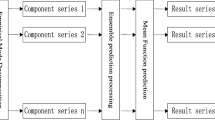Abstract
The paper is addressed to economic problems for which many different models can be proposed. In such situation the ensemble approach is natural way to improve the final prediction results. In particular, we present the method for the prediction improvement with ensemble method based on the multivariate decompositions. As a method for model results decomposition we present the smooth component analysis. The resulting components are classified as destructive and removed, or as constructive and recomposed. The classification of the components is based on the theoretical analysis of MSE error measure. The robustness of the method is validated through practical experiment of energy load consumption in Poland.
Access this chapter
Tax calculation will be finalised at checkout
Purchases are for personal use only
Preview
Unable to display preview. Download preview PDF.
Similar content being viewed by others
References
Breiman, L.: Bagging predictors. Machine Learning 24, 123–140 (1996)
Cardoso, J.F.: High-order contrasts for independent component analysis. Neural Computation 11, 157–192 (1999)
Cichocki, A., Amari, S.: Adaptive Blind Signal and Image Processing. John Wiley, Chichester (2002)
Golub, G.H., Van-Loan, C.F.: Matrix Computations. Johns Hopkins (1996)
Haykin, S.: Neural networks: a comprehensive foundation. Macmillan, New York (1994)
Hoeting, J., Modigan, D., Raftery, A., Volinsky, C.: Bayesian model averaging: a tutorial. Statistical Science 14, 382–417 (1999)
Hyvärinen, A., Karhunen, J., Oja, E.: Independent Component Analysis. John Wiley (2001)
Lendasse, A., Cottrell, M., Wertz, V., Verdleysen, M.: Prediction of Electric Load using Kohonen Maps – Application to the Polish Electricity Consumption. In: Proc. of Am. Control Conf., Anchorage AK, pp. 3684–3689 (2002)
Lee, D.D., Seung, H.S.: Learning of the parts of objects by non-negative matrix factorization. Nature 401, 788–791 (1999)
Li, Y., Cichocki, A., Amari, S.: Sparse component analysis for blind source separation with less sensors than sources. In: Fourth Int. Symp. on ICA and Blind Signal Separation, Nara, Japan, pp. 89–94 (2003)
Mitchell, T.: Machine Learning. McGraw-Hill, New York (1997)
Stone, J.V.: Blind Source Separation Using Temporal Predictability. Neural Computation 13(7), 1559–1574 (2001)
Szupiluk, R., Wojewnik, P., Zabkowski, T.: Model Improvement by the Statistical Decomposition. In: Rutkowski, L., Siekmann, J.H., Tadeusiewicz, R., Zadeh, L.A. (eds.) ICAISC 2004. LNCS (LNAI), vol. 3070, pp. 1199–1204. Springer, Heidelberg (2004)
Szupiluk, R., Wojewnik, P., Ząbkowski, T.: Smooth Component Analysis as Ensemble Method for Prediction Improvement. In: Davies, M.E., James, C.J., Abdallah, S.A., Plumbley, M.D. (eds.) ICA 2007. LNCS, vol. 4666, pp. 277–284. Springer, Heidelberg (2007)
Yang, Y.: Adaptive regression by mixing. Journal of American Statistical Association 96, 574–588 (2001)
ForexNewsNow: Automated Trading: Pros and Cons (published July 7, 2011), http://forexnewsnow.com/forex-brokers/automated-trading-pros-and-cons/
Author information
Authors and Affiliations
Editor information
Editors and Affiliations
Rights and permissions
Copyright information
© 2012 Springer-Verlag Berlin Heidelberg
About this paper
Cite this paper
Szupiluk, R., Wojewnik, P., Ząbkowski, T. (2012). Smooth Component Analysis and MSE Decomposition for Ensemble Methods. In: Jezic, G., Kusek, M., Nguyen, NT., Howlett, R.J., Jain, L.C. (eds) Agent and Multi-Agent Systems. Technologies and Applications. KES-AMSTA 2012. Lecture Notes in Computer Science(), vol 7327. Springer, Berlin, Heidelberg. https://doi.org/10.1007/978-3-642-30947-2_64
Download citation
DOI: https://doi.org/10.1007/978-3-642-30947-2_64
Publisher Name: Springer, Berlin, Heidelberg
Print ISBN: 978-3-642-30946-5
Online ISBN: 978-3-642-30947-2
eBook Packages: Computer ScienceComputer Science (R0)




